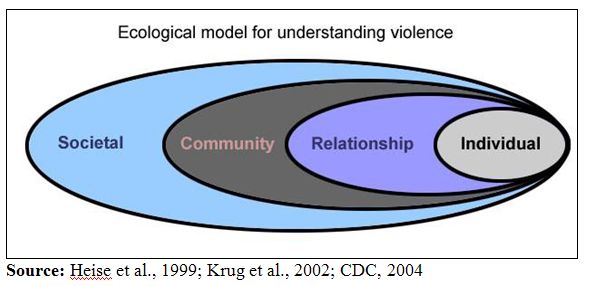- Programme design should be informed by the ecological model, which presents risk factors at the individual level in combination with risk factors within relationships or the family, the community, and at the broader societal/institutional level to assess the likelihood of a woman’s experiencing violence in a particular situation. (Heise, 1998)

- The ecological approach aims to ensure that interventions consider and address the conditions across different levels (e.g. individual, family, community and society), which affect women and girls’ risks of experiencing violence. As illustrated in the model there are biological, social, cultural and economic factors and norms at each layer that may increase men’s risk of perpetrating violence and a woman’s risk of experiencing it. Illustrative factors include:
- Witnessing marital violence or experiencing abuse as a child; having an absent or rejecting father; and substance abuse at the individual level.
- Marital conflict; male control over family wealth and decision-making; and age and education disparities between spouses at the relationship level.
- Lack of economic opportunities for men; negative influence of social peers; and women’s isolation from family and peers at the community level.
- Social norms granting or tolerating male control over female behavior; acceptance of violence as a conflict resolution method; concepts of masculinity linked to dominance, honour or aggression; and rigid gender roles at the societal level. (Heise, 1999; Morrison, et al., 2007)
- Interventions should also identify and reinforce the protective factors, or those that decrease the likelihood of women and girls experiencing violence, at each level within the ecological model. Protective factors that can support women’s and girls’ resilience against violence include, for example: education (especially completing secondary school); vocational skills; economic resources and opportunities; and social norms that promote gender equality.
- Programmes should be mindful of the different levels in the ecological model to achieve results, since each level is interconnected. However, it is not necessary to operate at all the levels, but to choose interventions at one or more level that will influence the risk and protective factors within other levels. For example, the norms at the community level influence behaviours and practices within homes and among relationships between men and women. Similarly, implementation of laws and policies at the societal level, for example, through institutionalization of protocols and training can improve police responses to survivors at the community level and discourage men from perpetrating violence in their homes.
